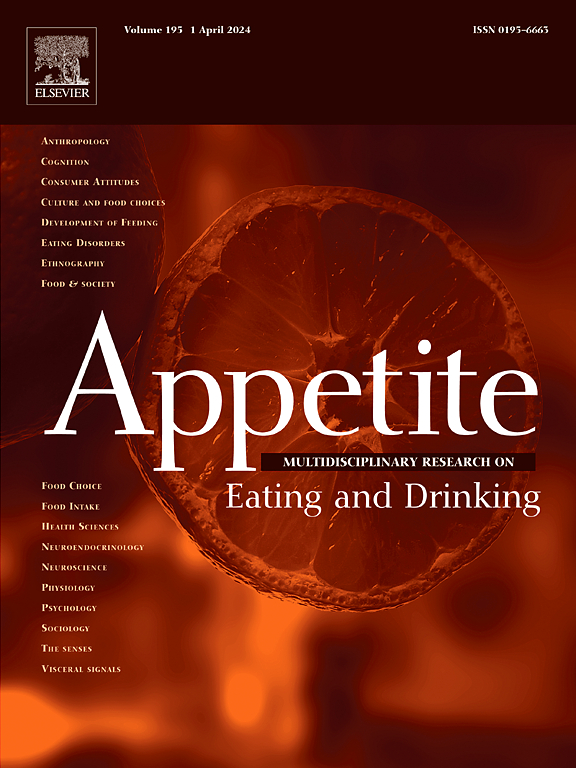植物性产品的感官和环境标签对消费者接受度的影响:背景、能量密度和框架因素。
IF 3.8
2区 医学
Q1 BEHAVIORAL SCIENCES
引用次数: 0
摘要
用植物蛋白代替动物蛋白的压力越来越大。消费者研究表明,感官特性和环境是影响pbf采用的主要因素,但很少有研究对这些因素进行对比。知道健康标签对感官体验有负面影响,我们测试了环境标签是否有同样的负面影响。通过一项在线调查,志愿者(N = 328)被随机分配到三种标签环境中的一种:感官(强调味道和质地)、环境(强调可持续性和环境影响)或控制(没有特定的信息),在那里他们评估了八种植物性替代食品。每种产品都通过积极或消极的框架声明得到增强,其中一半食物的能量密度更高,一半食物的能量密度更低。参与者对预期的喜欢、想要和可能的推荐进行评级,并估计他们会为每种食物支付多少钱。对于喜欢和推荐,环境背景和感官背景之间没有显著差异(p= 0.94),但两者都显著高于对照组(p=0.0006),而对于期望只希望感官(p=0.0014)超过对照组。环境组愿意支付的金额明显高于感官组(p=0.0005)和对照组(p=0.0005)本文章由计算机程序翻译,如有差异,请以英文原文为准。
Effects of sensory and environmental labelling of plant-based products on consumer acceptance: Context, energy density and framing factors
There is growing pressure to replace animal-sourced proteins with plant-based proteins. Consumer studies suggest sensory properties and environment are the major factors impacting adoption of PBFs, but few studies have contrasted these factors. Knowing that health labels negatively impact sensory experience, we tested whether environmental labels had the same negative impact. Using an online survey, volunteers (N = 328) were randomly assigned to one of three label contexts: sensory (emphasizing taste and texture), environmental (highlighting sustainability and environmental impact), or control (no specific messaging), where they evaluated eight plant-based alternative foods. Each product was enhanced by either a positive or a negatively valanced framing statement, with half the foods higher, and half lower, in energy density (ED). Participants rated expected liking, wanting and likely recommendation, and estimated what they would pay for each food. For liking and recommending, there was no significant difference between environmental and sensory contexts (p = 0.94), but both were significantly higher than control (p = 0.0006), while for expected wanting only the sensory exceeded the control (p = 0.0014). The amount willing to pay was significantly higher in the environmental than sensory (p = 0.0005) or control (p < 0.0001) contexts, which did not differ significantly (p = 0.49). For all four measures, higher ED foods were rated significantly more positively than lower ED (p < 0.001), while the effect of environment on purchase price was magnified by higher ED foods (p < 0.001). Positive framing statements were rated significantly higher than negative framing for liking (p < 0.001), wanting (p < 0.001) and recommending (p = 0.022), but not for purchase (p = 0.30). When habitual diet (plant-based or not) was included in the exploratory analyses, it only altered acceptance of lower energy-dense products in the control context. Overall, these data suggest that the use of environmental descriptors may enhance consumer expectations and willingness to pay more to the same degree as sensory descriptors, providing various strategies for marketers and product developers to promote PBFs based on messages that best fit the brand identity and expand the PBFs narrative beyond health.
求助全文
通过发布文献求助,成功后即可免费获取论文全文。
去求助
来源期刊

Appetite
医学-行为科学
CiteScore
9.10
自引率
11.10%
发文量
566
审稿时长
13.4 weeks
期刊介绍:
Appetite is an international research journal specializing in cultural, social, psychological, sensory and physiological influences on the selection and intake of foods and drinks. It covers normal and disordered eating and drinking and welcomes studies of both human and non-human animal behaviour toward food. Appetite publishes research reports, reviews and commentaries. Thematic special issues appear regularly. From time to time the journal carries abstracts from professional meetings. Submissions to Appetite are expected to be based primarily on observations directly related to the selection and intake of foods and drinks; papers that are primarily focused on topics such as nutrition or obesity will not be considered unless they specifically make a novel scientific contribution to the understanding of appetite in line with the journal's aims and scope.
 求助内容:
求助内容: 应助结果提醒方式:
应助结果提醒方式:


